
About UsThe Numismatic Bibliomania Society is a non-profit organization promoting numismatic literature. For more information please see our web site at coinbooks.org SubscriptionsThose wishing to become new E-Sylum subscribers (or wishing to Unsubscribe) can go to the following web page link MembershipThere is a membership application available on the web site Membership Application To join, print the application and return it with your check to the address printed on the application. Membership is only $20 to addresses in the U.S., $25 for First Class mail, and $30 elsewhere. For those without web access, write to: David M. Sundman, Treasurer AsylumFor Asylum mailing address changes and other membership questions, contact David at this email address: dsundman@LittletonCoin.com SubmissionsTo submit items for publication in The E-Sylum, just Reply to this message, or write to the Editor at this address: whomren@gmail.com
BUY THE BOOK BEFORE THE COIN |
- WAYNE'S WORDS: THE E-SYLUM APRIL 27, 2014
- JOHN W. ADAMS RECEIVES HUNTINGTON AWARD HONOR
- BOOK REVIEW: AMERICAN NUMISMATIC AUCTIONS TO 1875: VOLUME 1
- BOOK REVIEW: U. S. LIBERTY HEAD $20 DOUBLE EAGLES
- A BIG BOOK: A CALIFORNIA GOLD RUSH HISTORY
- BOB EVANS SETS SAIL FOR THE S.S. CENTRAL AMERICA
- ON COMPARING HAND-ENGRAVING STYLES
- NOTES FROM E-SYLUM READERS: APRIL 27, 2014
- SMITHSONIAN NUMISMATIC GALLERY TO OPEN JULY 2015
- VOLUNTEERS SOUGHT FOR SMITHSONIAN NUMISMATIC DIGITIZATION
- LINCOLN CENT TYPOGRAPHY DESIGN HISTORY
- HONEY, I SHRUNK THE MEDALS!
- THE EMPIRE COIN COMPANY OFFICE
- 1978 NEW YORK ASSAY OFFICE GOLD THEFT
- INSIDE STORY OF THE SACAGAWEA DOLLAR
- MORE ON THE FINLAND 10 EURO LITERACY COIN
- CANADIAN COIN DESIGNER KENDRA DIXSON INTERVIEWED
- COMMEMORATIVE COIN ON RUSSIA'S CRIMEA SIEZURE
- AUSTRALIAN VICTORIA CROSS COMMEMORATIVE COINS
- PERTH MINT COIN DESIGNER ING ING JONG
- SOME INTERESTING MEDALS: APRIL 27, 2014
- COUNTERFEITERS OF BRITISH ONE POUND COINS ARRESTED
- ROYAL MINT TO OPEN VISITOR CENTRE IN 2015
- SHOCKING DISCOVERY: DOLLAR BILLS CARRY BACTERIA
- TWELVE GOLD BARS FOUND IN MAN'S STOMACH
- FEATURED WEB SITE: MINT DIRECTORS’ CONFERENCE 2014
Click here to access the complete archive
To comment or submit articles, reply to whomren@gmail.com
WAYNE'S WORDS: THE E-SYLUM APRIL 27, 2014

Our new subscribers this week include Bob Williams, courtesy of John W. Adams, Sarah Miller of Heritage, Mark Klein, Bobby Allen and Joe O'Donnell. We have 1,722 email subscribers.
This week we open with reports from yesterday's 2014 Archer M. Huntington Award ceremony in Boston, followed by two book reviews from CoinWeek. Other topics include the return to the S.S. Central America wreck, hand-engraving styles, the planned new exhibit gallery for the National Numismatic Collection at the Smithsonian, and coin designers Kendra Dixson and Ing Ing Jong.
To learn more about a recidivist collector, Dave Bowers' eleven-pound book, the Walton & Co. New Orleans Hard Times Token, the typography of Lincoln cent lettering, the Copper Lady, Bob Leuver's New York Welcome, and the National Banknotes of the First National Bank of Crows Landing, CA, read on. Have a great week, everyone!
Wayne Homren
Editor, The E-Sylum
JOHN W. ADAMS RECEIVES HUNTINGTON AWARD HONOR
 Author and Numismatic Bibliomania Society past president John W. Adams received the American Numismatic Society's prestigious Huntington award last night at a ceremony attended by some 80 hobby luminaries.
Past recipients include Edward Newell, José Toribio Medina, Sydney P. Noe, A. F. Pradeau, C.H.V. Sutherland, Philip Grierson, R.A.G. Carson, Eric P. Newman, John S. Davenport and Joseph E. Cribb.
Author and Numismatic Bibliomania Society past president John W. Adams received the American Numismatic Society's prestigious Huntington award last night at a ceremony attended by some 80 hobby luminaries.
Past recipients include Edward Newell, José Toribio Medina, Sydney P. Noe, A. F. Pradeau, C.H.V. Sutherland, Philip Grierson, R.A.G. Carson, Eric P. Newman, John S. Davenport and Joseph E. Cribb.
The 2014 Archer M. Huntington Award ceremony was held from 4:30 to 6:30 PM April 26th at the Massachusetts Historical Society in Boston. The award is conferred annually in honor of the ANS benefactor Archer M. Huntington in recognition of outstanding career contributions to numismatic scholarship. The medal was designed in 1908 by Emil Fuchs to commemorate the 50th anniversary of the founding of the ANS.
From the event press release:
The Trustees of the American Numismatic Society have voted to award John W. Adams the 2014 Archer M. Huntington Award in recognition of his outstanding career contributions to numismatic scholarship. The award ceremony will be held on Saturday, 26 April 2014 at the Massachusetts Historical Society in Boston. The event will include Mr. Adams’ presentation of the Silvia Mani Hurter Memorial Lecture, titled A Recidivist Collector, followed by a reception in his honor.
John Adams’ research in the field of numismatics focuses on American and European medals, numismatic literature, and large cents. In his early research, his approach is largely bibliographical. His Monographs on Varieties of United States Large Cents, 1793–1794, published in 1976, provided a concise introduction to the various key publications in this field. His two volumes of United States Numismatic Literature (1982, 1990) are among the most useful bibliographical aids on American numismatic auction catalogues available; in particular Adams’ erudite introductions to the various collectors are widely quoted.
In the last 15 years, Adams has focused primarily on medals, both European and American. His book The Indian Peace Medals of George III, or, His Majesty’s Sometime Allies, published in 1999, demonstrates his breadth of knowledge; through careful numismatic analysis Adams was able to expand our knowledge in this series. His approach to medals is largely historical, and his subsequent work on The Medals Concerning John Law and the Mississippi System has become a standard work on the peculiar medals satirizing this famous financial crisis of the early 18th century. In this book Adams illustrates his command of historical, financial and numismatic matters.
Together with Anne Bentley, Adams wrote Comitia Americana and Related Medals: Underappreciated Monuments to Our Heritage (2007). In this exhaustive analysis, Adams and Bentley re‐wrote our understanding of this important early American series of medals. It is now the definitive historical and numismatic study on the subject. Again, in 2010 Adams wrote the consummate book Medallic Portraits of Admiral Vernon: Medals Sometimes Lie with Fernando Chao and in collaboration with Anne Bentley. This work provides a study of the many varieties of the Vernon series, which often differ only in tiny details, provides historical context, offering a concordance with the many prior studies and much more.
While there is an impressive corpus of books by Adams, he also is a frequent contributor to conference proceedings, journals and other publications. He has published articles about coin sales, individual medals, numismatic personalities, and hoards, to name just a few. His long involvement as editor of The MCA Advisory has turned this publication into a popular, well-‐ informed publication.
The Chairman of the Society’s Huntington Committee, Dr. Jere Bacharach, described the honoree with the following words: “What distinguishes John Adams from other writers is his passion for history, a beautiful, academically correct writing style, and diligence in seeking out overlooked historical and numismatic sources.”
John W. Adams received an AB from Princeton (1957) and a MBA from Harvard (1959). He founded Adams, Harkness & Hill in 1966, an investment bank in Boston, where for the next 40 years he served variously as Director of Research, Chairman and CEO. He has served as a Trustee of the Massachusetts Historical Society, where he was instrumental in conserving its coin cabinet, and as President of the Numismatic Bibliomania Society and the Medal Collectors of America. He is a Fellow of the American Antiquarian Society, as well a Fellow of the American Numismatic Society where he also served on its Board of Trustees and was an active Chairman of the Library Committee.
ANS Executive Director Ute Wartenberg-Kagan officiated at the ceremony, which was followed by a dinner at The Country Club in Brookline. NBS charter member and Historian Joel Orosz served as Toastmaster and provided this report on the day's events for The E-Sylum. Thanks!
The American Numismatic Society’s justly esteemed Archer M. Huntington Award is not given, nor even conferred, it is earned. Such is the prestige attached to this recognition of outstanding career contributions to numismatic scholarship that the ANS comes to the awardee, rather than the other way around: in short, the recipient of the Huntington chooses the venue where it will be awarded. 2014 Huntington honoree John Weston Adams chose to accept the award on Saturday, April 26, 2014 at the nation’s oldest historical institution, the Massachusetts Historical Society, and to celebrate afterwards with family, friends and two “gangs” of numismatists at The Country Club in Brookline, also the nation’s first in that field.
Anne Bentley, loyal NBS member, whose curatorial duties embrace the superb Massachusetts Historical Society numismatic collection, was the genial host at the MHS. To mark the occasion, she had mounted an exhibition featuring a boxed set of previously-owned Comitia Americana medals from the Society’s collection. Given the fact that Thomas Jefferson commissioned the box, and that the previous owners of the medals were George Washington and Daniel Webster, no one present complained about them being “used.”
ANS Executive Director Ute Wartenberg Kagan and Board Chair Kenneth L. Edlow jointly presented the Huntington Award to Adams, noting that it has been nicknamed, with more than a little justification, the “Nobel Prize of Numismatics.” Adams’ acceptance address, aptly entitled “A Recidivist Collector,” recounted his lifelong pattern of forming superb collections, writing definitive references on them, and then selling them and proceeding to another collecting challenge.
He credited his mother for piquing his numismatic interest, and the dealers David Bullowa and Lester Merkin for counseling him to seek quality in all he collected. Adams shared anecdotes in his trademark sparkling style, recounting the building, researching, writing, and dispersal of his memorable collections of 1794 cents, Betts Medals, Vernon Medals, and numismatic literature. The reception following, held in the MHS’s magnificent Dowse Library room, evoked memories of the 2010 NBS annual meeting, held, with the connivance of John and Anne, in that very bibliophilic chamber.
After a short bus ride to The Country Club, a group of 56 Adams acolytes, about evenly split between John’s friends and family on the one hand, and members of his numismatic “gangs” on the other, continued the celebration over dinner. Any slight possibility that awkwardness would arise between, as John archly put it, the “Numismatists” and the “Normals” quickly evaporated when Master of Ceremonies Joel J. Orosz asked the assembled group to share “something we don’t know, but should” about the guest of honor.
The responses that poured forth sculpted a many-faceted portrait of John W. Adams as an exemplar in business; a quietly generous leader in philanthropy; and a mentor to many in numismatics. One poignant contribution allows us to take the measure of the man; when he received a phone call informing him that an old friend was dying on Prince Edward Island, he dropped everything to rush to his friend’s bedside in time to say goodbye. Yet a youth spent in perhaps too closely reading Booth Tarkington’s Penrod novels was revealed when his children and grandchildren informed us that it was John who had taught them how to construct surgical tubing slingshots and butter-launching napkin snappers, all with predictably disastrous results for the integrity of nearby neighbors’ windows and kitchen ceilings.
Perhaps the best way to measure the esteem in which John is held is to note that every member of both of his “gangs”, drawn from the ranks of the Numismatic Bibliomania Society and the Medal Collectors of America, traveled from their homes across the country to share in this celebration with him. Among the NBS members in attendance were Q. David Bowers, George Frederick Kolbe, Len Augsburger, Joel J. Orosz, David Fanning, Charles Davis, Tony Lopez, Anne Bentley, Barry Tayman, Warren Baker, and John Lupia.
Regina Adams, John’s wife and partner in all things (with the notable exceptions of surgical tubing rocketry and butter-launching napkin systems) organized The Country Club dinner with her signature graciousness. The evening ended on a fitting note, comparing John and Regina to bells in a carillon. Neither of them are necessarily the biggest or the loudest bells in the carillon; rather, both are of the most desirable kind: those that ring true every time.
NBS Board member and numismatic literature dealer David Fanning provided several pictures of the event, as did Bob Williams. Thanks!
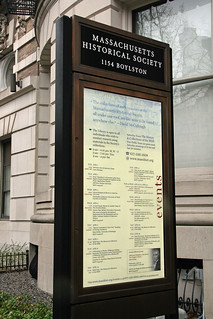
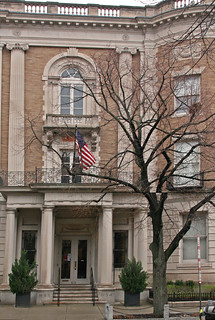
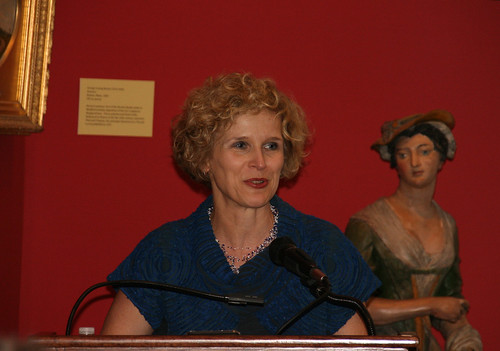
Ute Wartenberg-Kagan
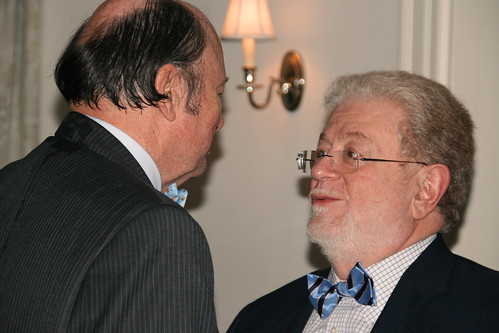
John Adams and Barry Tayman
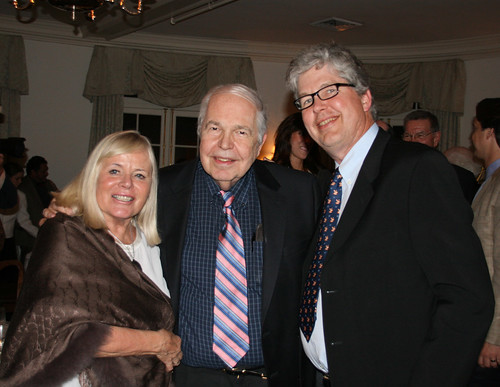
Regina Adams, Dave Bowers, Wynn Bowers
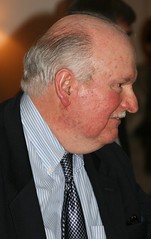 Others in attendance included former ANS Librarian Frank Campbell (pictured here), John Sallay, Warren Baker, Skyler Liechty, Arthur Houghton, Mary Lannin, and Arthur Fitts.
Others in attendance included former ANS Librarian Frank Campbell (pictured here), John Sallay, Warren Baker, Skyler Liechty, Arthur Houghton, Mary Lannin, and Arthur Fitts.
Congratulations to Mr. Adams for a very well-deserved honor. I am in awe of his body of work. No amount of medals, ribbons or awards could come close to matching the massive dedication and scholarship he has devoted to numismatic research and literature. His works will stand as classic references on their respective subjects for centuries to come.
His paper, A Recidivist Collector, will be published in a future issue of ANS Magazine.
For more information about the Huntington Award, see: The 2014 Archer M. Huntington Award (numismatics.org/NewsEvents/Huntington2014)
For more information about the Huntington Medal, see: Awards Given by the American Numismatic Society (numismatics.org/Archives/Awards)
To read the complete Press Release, see: The American Numismatic Society awards its 2014 Archer M. Huntington Award for excellence in numismatic scholarship to John W. Adams (numismatics.org/wikiuploads/NewsEvents/2014_0218_PR_HuntingtonAward.pdf)

BOOK REVIEW: AMERICAN NUMISMATIC AUCTIONS TO 1875: VOLUME 1
 American Numismatic Auctions to 1875: Volume 1: American Numismatic Auctions 1738-1850, by John N. Lupia III
American Numismatic Auctions to 1875: Volume 1: American Numismatic Auctions 1738-1850, by John N. Lupia III
John N. Lupia III’s American Numismatic Auctions is a revised and expanded edition of Part One of E. J. Attinelli’s landmark 19th century work Numisgraphics, or, A List of Catalogues, In Which Occur Coins or Medals, Which Have Been Sold By Auction in the United States, Also, A List of Catalogues or Price Lists of Coins, Issued by Dealers, Also, A List of Various Publications of More of Less Interest to Numismatologists, Which Have Been Published in the United States, Compiled by E. J. Attinelli.
For those unfamiliar with Emmanuel Joseph Attinelli and his canonical reference work Numisgraphics, know that in the late mid-19th century, coin collecting in the United States was experiencing what some have called its first boom. Public auctions in major U.S. cities like Philadelphia and New York became an increasingly important means for dealers, buyers and sellers to acquire and liquidate holdings.
Attinelli and his unnamed co-author (widely believed to be Daniel Parish, Jr., author of an article published in 1866 in the American Journal of Numismatics entitled “List of Catalogues of Coin Sales, Held in the United States from 1828 to the Present”) set out to document a chronological history of all known sales.
The earliest sale they documented was an auction of ancient coins & copperplate engravings belonging to the estate of the late Benjamin H. Watkins of Salem, Massachusetts. (82) From this starting point, Attinelli documented more than 400 sales of numismatic items (excluding paper money and numismatic literature) through to Attinelli’s present day (in this case, 1876).
For more than a century, Attinelli’s work has supported our understanding of the development of modern coin auctions and served as a history of the hobby in the early decades of our country. Lupia, with his new volume, asserts that Attinelli’s Numisgraphics is woefully incomplete and sets out to improve the work, as much as possible, with hundreds of additional entries.
Lupia’s American Numismatic Auctions to 1875: Volume 1 is a highly specialized volume that deals with a seminal period in American numismatic history. It’s not for everybody, and the insights it contains won’t prove very useful to the majority of hobby participants. It is, at its heart, an academic work, constructed for the sake of knowledge and beneficial primarily to those who explicitly seek what it provides. But it does give us something more. It preserves that which has proven to be much more fragile and fleeting than the tiny metal discs that have so captivated collectors for centuries.
John tells us that the second volume is nearly complete. Part two covers the remainder of Attinelli’s 443 coin auction listings and includes more than 200 new coin auctions–including sales of stocks, bonds, securities, and scrip. The second volume, he says, “will be a more diverse store of information on auctions in all numismatic fields than anything before published.”
For more information, or to order, see: sites.google.com/site/numismaticmallcom/
To read the complete article, see: First Read: American Numismatic Auctions to 1875: Volume 1 (www.coinweek.com/numismatic-history/first-read-american-numismatic-auctions-1875-volume-1/)
BOOK REVIEW: U. S. LIBERTY HEAD $20 DOUBLE EAGLES
 In his latest work, Bowers collaborates with financial historian and series specialist Robert Galiette to take on America’s highest denomination circulating coin, the gold double eagle.
In his latest work, Bowers collaborates with financial historian and series specialist Robert Galiette to take on America’s highest denomination circulating coin, the gold double eagle.
The book, U.S. Liberty Head $20 Double Eagles: The Gilded Age of Coinage, examines the 60 year period of the coin’s production, focusing on the social, industrial, and financial aspects of the American experience.
While it follows the year-by-year structure we’ve come to expect from books like this, it eschews the “by the numbers” approach (you know the drill; mintage numbers, flawed certified grade population reports, and somebody’s best guess at coin values–usually with no explanation of methodology) that can lose sight of what makes Numismatics interesting in the first place.
It’s a refreshing approach, and one that we think could gain some traction if only other writers would see the benefit of Bowers’ formula and frame their narratives by remembering that coins serve as a tool of commerce, struck for the benefit of the people that use them.
No doubt Galiette was aware that the two writers were treading down a road less travelled with this approach. “I had wanted to write about financial history and economics”, Galiette told us during a March telephone interview, “and Chris [Karstedt] and Dave would remind me it was a book about $20 Liberties.”
Ultimately, Galiette’s instincts were on the money, so to speak.
Readers who want to get a feel for the period will find the various topics and tangents interesting.
We found fascinating the stories of hooliganism in California at the height of the gold rush and historical documents that recount the tremendous difficulty the Mint endured to supply the branch in San Francisco with acids for assay purposes. Not to mention Bowers’ and Galiette’s knowledgeable insights into America’s 19th century silver euphoria, which drastically changed the course of American monetary policy and ultimately led to an epic political battle between the Silverites and the gold bugs in the latter part of the 19th century.
To read the complete article, see: First Read: U.S. Liberty Head $20 Double Eagles: The Gilded Age of Coinage (www.coinweek.com/featured-news/first-read-u-s-liberty-head-20-double-eagles-gilded-age-coinage/)
To read the earlier E-Sylum article, see: BOOK REVIEW: U. S. LIBERTY HEAD $20 DOUBLE EAGLES (www.coinbooks.org/esylum_v17n17a05.html)
THE BOOK BAZARRE
A BIG BOOK: A CALIFORNIA GOLD RUSH HISTORY
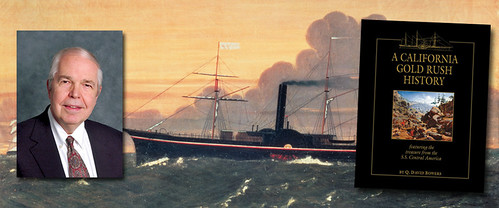
If you are an old timer, so to speak, you may remember back in 2002 when we published the book, A California Gold Rush History. The edition was limited to 4,000 copies and in time sold out. Today each is a collectors’ item.
Creating this was one of the most stimulating projects I have ever done. Dwight Manley, in charge of the California Gold Marketing Group that was selling the S.S. Central America treasure, underwrote the book, giving me an unlimited budget for research and travel. I sent several helpers off to different libraries and museums and, along the way, gather illustrations and other information that had never been published in a single book before.
The book, which weighs about 11 pounds, was even featured in a fictional crime scenario in a book, where someone was whacked with a copy!
Not so long ago I received a letter from J.R., a Pennsylvania reader, who wrote to say:
“Just wanted you to know that my New Year’s resolution this year was to take your California Gold Rush History/S.S. Central America 1055-page book that I bought several years ago and actually sit down and read it! Well, beginning New Year’s Day I did just that -- read every word including the Appendices, Index and all the footnotes. Thank you for not having made them end notes! Believe it or not it took me exactly 49 days of consecutive reading to complete it. I suppose that makes me a 49’er too, in a way!
“The book was great and I have no criticism of it in any way, although one suggestion would be that where it was stated that certain of the privately made ingots were auctioned by Sotheby’s, it would have been interesting to have had the sale prices listed as I wondered what each one realized. However, as is true of all your books (of which I have many), it was first class!”
Of course, the best “pay” that I or any author can ever receive is getting letters like this!
To read the complete article, see:
"A California Gold Rush History"
(www.stacksbowers.com/NewsMedia/Blogs/TabId/780/
ArtMID/2678/ArticleID/64474/A-California-Gold-Rush-History.aspx)
BOB EVANS SETS SAIL FOR THE S.S. CENTRAL AMERICA
Treasure-hunter Bob Evans has spent half his life dreaming about the SS Central America, a pre-Civil War steamship decaying in the lightless depths off South Carolina. Now he’s returning to the shipwreck after 23 years.
Evans, 60, set out this week with deep-ocean explorer Odyssey Marine Exploration Inc. (OMEX) to revisit the remains of the 19th-century sidewheel steamer, which sank in 1857 with the loss of 425 lives and an undetermined amount of gold. Despite recovery efforts in 1989 through 1991 that netted more than two tons of the precious metal, Odyssey says there may still be $86 million of gold lying more than a mile below the surface of the Atlantic.
“This is the greatest lost treasure in United States history,” Evans, who was chief scientist on the earlier expeditions, said in a phone interview before the ship sailed.
Even with the plunge in gold last year, the metal is still more than triple its price in the early 1990s, when previous recovery efforts were suspended because of legal battles over rights to the treasure. And the rare coins that have been found at the site are selling for much more than their weight in gold.
For Odyssey, the Central America shipwreck offers another chance to show the potential gains from deep-sea salvaging.
“Our research department and the court-appointed experts all believe there is enough gold remaining at the SS Central America to warrant the expense of conducting an expedition,” Odyssey President Mark Gordon said last month in an e-mail.
“It’s essentially a four-story collapsed building at the bottom of the sea,” said Evans, who was one of a handful of people in the ship’s control room who watched the deep-water discoveries via video transmissions from a camera aboard a remotely operated robot called Nemo.
Using the robot, which can withstand deep-sea pressures of 4,000 pounds per square inch, the expeditions found gold flakes, coins and bars over the following three years, according to Thompson’s 1998 book “America’s Lost Treasure.”
Thompson’s operations were cut short by legal battles, beginning with lawsuits filed by insurance companies, banks and underwriters. Thompson’s group eventually successfully defended the right to 92.5 percent of the artifacts it recovered and the right as salvor to recover what remained at the wreck.
To read the complete article, see: Sunken Gold Untouched for 157 Years Off U.S. Lures Hunter (www.bloomberg.com/news/2014-04-25/sunken-gold-untouched-for-157-years-off-u-s-lures-hunter.html)
ON COMPARING HAND-ENGRAVING STYLES
Recently I acquired a set of 19th century books, signed by Laura Ingalls (Little House on the Prairie author). The signature matched quite well the images I found online, but the form of her name did not. Young ladies of quality were taught penmanship such that MANY of them wrote pretty much identically.
Alan Weinberg's contention that many of his pieces were engraved by a single hand is plausible, but it is not unlikely a similar phenomenon is at play. Unfortunately (but not earthshakingly), little is known about hand-engraving on coins. Who were the engravers? Were their services available widely? What did they charge?
A key question: How many pieces like Alan's could one engraver do in a day or two? For every piece Alan has, there may be have been many others done that do not survive.
Nonetheless, handwriting experts should be able to determine, in many cases, if two engraved coins are by the same hand, just as they make confident judgments about signatures on paper. In fact, because engraving creates depth, the diagnostics (on unworn examples) may be very strong. Examining pieces in hand, next to each other, would be much better than comparing photographed or pixelated evidence.
To read the earlier E-Sylum article, see: PETER BERTRAM ON DAVIS FLIGHT MEDALS (www.coinbooks.org/esylum_v17n17a12.html)
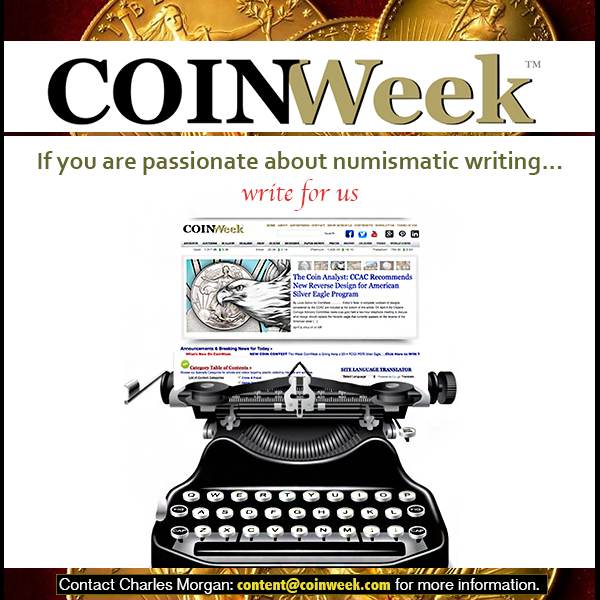
NOTES FROM E-SYLUM READERS: APRIL 27, 2014
The Point Loma Theater Bookstore Greg Adams writes:
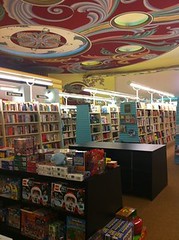 Roger Burdette's article on the most beautiful book stores reminds me of the fate of the Point Loma Theater here in San Diego.
The derelict theater was purchased by the “Bookstar” company and restored in the 1990’s before “Bookstar” was bought out by Barnes and Nobel. The theater originally had an ornate painted ceiling that was restored when the building was revitalized. Not quite as dramatic as the “El Ateneo Bookshop, Buenos Aires, Argentina” but the same basic idea.
Roger Burdette's article on the most beautiful book stores reminds me of the fate of the Point Loma Theater here in San Diego.
The derelict theater was purchased by the “Bookstar” company and restored in the 1990’s before “Bookstar” was bought out by Barnes and Nobel. The theater originally had an ornate painted ceiling that was restored when the building was revitalized. Not quite as dramatic as the “El Ateneo Bookshop, Buenos Aires, Argentina” but the same basic idea.

For more information, see:
Loma Theatre
3150 Rosecrans Boulevard, San Diego, CA 92110
(cinematreasures.org/theaters/1716/photos)
(www.yelp.com/biz_photos/bookstar-barnes-and-noble-san-diego?select=3pJOcwkyUtLY6BdJllDvYg#3pJOcwkyUtLY6BdJllDvYg)
To read the earlier E-Sylum article, see: THE WORLD'S MOST BEAUTIFUL BOOKSHOPS (www.coinbooks.org/esylum_v17n17a26.html)
Fake Gold Qing Dynasty Coin Scam
To read the complete article, see: Woman Arrested After $50,000 Fake Coin Fraud (www.cambodiadaily.com/news/woman-arrested-after-50000-fake-coin-fraud-56784/)
CSNS John Burns Memorial Book Signing Table Bruce Perdue of CSNS writes:
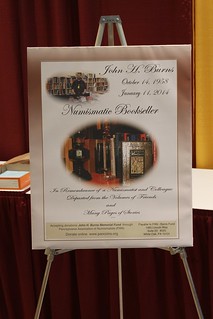 I have attached a photo of the sign at the John Burns Memorial book Signing table from the Central States Numismatic Society's 75 Anniversary convention. While I was busy with other show duties it seemed that the authors were getting some activity. I can further report that the CSNS board voted a $500 donation to the John Burns Memorial Fund.
I have attached a photo of the sign at the John Burns Memorial book Signing table from the Central States Numismatic Society's 75 Anniversary convention. While I was busy with other show duties it seemed that the authors were getting some activity. I can further report that the CSNS board voted a $500 donation to the John Burns Memorial Fund.
To read the earlier E-Sylum article, see: JOHN BURNS ESTATE UPDATE: APRIL 20, 2014 (www.coinbooks.org/esylum_v17n17a14.html)
Hussey's Private Message Post Werner Mayer writes:
I feel that the article about the stamp dealer and Civil War Token is not totally correct. I wrote an article in the Civil War Token Society Journal Volume 20 No 1 Werner About Husseys Private Message Post. He delivered mail and sold his own private postage stamps. He also issued his own civil war token 630AK. My article also found its way to the Internet as "Hussey's Private Message Post".
Werner writes:
My contention is that Hussey sold stamps for his service. You went to his store and bought stamps either as a customer of his message service or as a collector of stamps. These stamps were in great demand by stamp collectors and are quite expensive and scarce.
So if he sold stamps he was a stamp dealer. He originally sold his stamps at $1 for 100 and gradually increased the price to 2 cents a stamp in 1863. I guess it is a matter of semantics as what a stamp dealer is.
Hussey was established in the 1840s. Postage stamps were first issued by Great Britain in 1840. The private posts issued stamps in 1841. The U.S.P.S issued its stamps in 1845. I hope this explains my premise as to the definition of a "stamp dealer". The business was still in existence in the 1880s.
I have written approximately 20 to 30 articles for CWTS and TAMS mostly concerning New York City store cards 20 to 30 years ago. Most of my research was done in the New-York Historical Society and the New York Public Library.
To read the earlier E-Sylum article, see: NUMISMATIC RESEARCH IN PHILATELIC PUBLICATIONS (www.coinbooks.org/esylum_v17n17a11.html)
Siberian Club Seeks Coin Donations Jura Iwlew of Nowoaltaisk, Russia writes:
My name is Jura, my age is 13 years. Recently I and my friends organized a children's club Knight, who has been studying the history of numismatics and its development at the moment. So our club wants to organize and conduct a number of activities for the development of knowledge for anyone who is interested in numismatics. Our club will promote numismatics in our small Siberian town. Many children are addicted to collect coins! My friends and I would be very grateful if you can send free unnecessary small coins in your country for our courtyard of the museum, which is attended by children and their parents. We hope that this goodwill that contribute to the development of worldwide child numismatics ! We wish you a nice day ! My address: Street: Belyakowa, 62; City: Nowoaltaisk; State: Altayskiy krai; Zip: 658084; Country: Russian Federation
Walton & Co. Hard Times Token
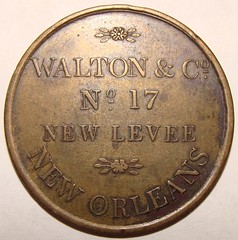
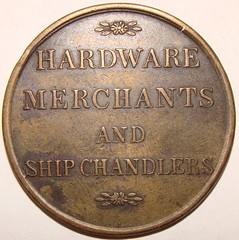
Lloyd Wagner forwarded this information about a rare Hard Times Token he acquired recently:
A very rare Walton & Co. Hard Times Token (Rulau HT-128, Low 288 ) was recently found in California. Only five others have been identified.
A rather plain, unpretentious piece, this token is dated 1841-1844 by Rulau, and is one of the few very desirable New Orleans, Louisiana tokens known from this merchant.
33 mm - R8 rarity - WALTON & CO. / NO. 17 / NEW LEVEE / NEW ORLEANS // HARDWARE / MERCHANTS / AND / SHIP CHANDLERS
According to Webster, a "chandler" is "a retail dealer in provisions and supplies or equipment of a specified kind: a yacht chandler"
Man Sows Coins on Beach Regarding our discussion of the meaning of buried coin finds, Fred Michaelson forwarded an image of a July 10, 2010 Ocean City, MD newspaper article about a man who placed coins from his old collection in the sand at a local beach for future collectors to find.
An Ocean Pines resident wanted to do something to give back to the community after his retirement, and for the past few weeks he has been discreetly dropping hundreds of coins from around the world into the sand along the beach for beachgoers to find.
"I thought this might be an interesting way to get rid of my coin collection and hopefully bring a smile to kids' faces and stimulate their interest in coins."
The coins are from countries as varied as England, Australia, Pakistan, South Africa, Cuba and China, and some are up to 100 years old.
To read the earlier E-Sylum article, see: NUMISMATIC VOCABULARY: TERMINUS POST QUEM (www.coinbooks.org/esylum_v17n16a22.html)

Archives International Auctions, Part XIX
U.S. & Worldwide Banknotes, Scripophily, Security Printing Ephemera, "The Tasmanian Devil Collection" of rare Australian & New Zealand Banknotes and Further Selections from the Hamtramck Collection.
Highlights include:
- Lot 33 Commonwealth of Australia, Reserve Bank, ND (1974) Issue $50 Specimen Banknote
- Lot 494 Bank of America, 1879 Specimen $10,000 Clearing House Certificate
- Lot 589 Accelerating Steam Navigation Co., 1852 Issued Stock Certificate - Obsolete Look-A-Like

1580 Lemoine Avenue, Suite #7
Fort Lee, NJ 07024
Phone: 201-944-4800
Email: info@archivesinternational.com
WWW.ARCHIVESINTERNATIONAL.COM
SMITHSONIAN NUMISMATIC GALLERY TO OPEN JULY 2015

The 1,000-square-foot gallery is part of the museum’s overall West Wing renovations. The gallery space, triple what is currently devoted to numismatics, is scheduled to be ready for the public in July 2015.
Museum officials project that the gallery will be able to accommodate 1 million visitors annually. Access to the exhibit area will be closest from the Constitution Avenue entrance.
The National Numismatic Collection, containing nearly 1.6 million objects, is the largest numismatic collection in North America and one of the largest in the world. Coins, medals and decorations in the collection total more than 450,000; paper money accounts for another 1.1 million pieces. As a whole, the collection highlights the entire numismatic history of the world.
The Gallery of Numismatic History’s six display cases, covered with Plexiglas, are designed to exhibit small objects.
Each case will be accompanied by pull-out discovery drawers positioned below, to expand the number of objects displayed, according to museum officials. The contents of the display drawers will be rotated in and out regularly.
The objects will be secured so that they can be viewed, but not individually handled or removed, by the public.
The six display cases are designed to permit double-sided viewing of coins, medals, tokens, paper money and other numismatic objects. Each display case will be dedicated to specific themes tracing the evolution of money, its development and uses.
Representations of Liberty, symbols of national strength and related motifs will be among the topics explored. Items to be represented will include primitive money, such as Yap stones; specie; and technological advances, incorporating such items as credit cards and virtual currency.
To read the complete article, see: Smithsonian moving ahead with Gallery of Numismatic History tripling current space for NNC (www.coinworld.com/insights/numismatic-exhibit-at-smithsonian-moving-ahead-for-july-15-openi.html)
VOLUNTEERS SOUGHT FOR SMITHSONIAN NUMISMATIC DIGITIZATION
 The Smithsonian Institution is seeking volunteers at its transcription center to create digital images for online illustration of items in its museums, which includes the National Numismatic Collection at the National Museum of American History.
The Smithsonian Institution is seeking volunteers at its transcription center to create digital images for online illustration of items in its museums, which includes the National Numismatic Collection at the National Museum of American History.
The current focus involving the National Numismatic Collection is to digitize the thousands of certified proofs for paper currency.
According to https://transcription.si.edu, "Since 1863, certified proofs allowed the Bureau of Engraving and Printing to examine every intaglio printing plate before it was placed in production."
Each certified proof is being cataloged and digitized, with appropriate descriptive information added to each image that will be posted online.
Visit the main Smithsonian Transcription Center webpage at https://transcription.si.edu to learn about the efforts being conducted in the Smithsonian family of museums. From the main page, access the drop-down window under the title "Browse Subjects" and click on the link to National Museum of American History.
The section on certified proofs is located at https://transcription.si.edu/project/6691.
To read the complete article, see: Smithsonian Institution seeks volunteers to help digitize items in the National Numismatic Collection (www.coinworld.com/news/smithsonian-seeks-volunteers-to-digitize-national-numismatic-col.html)

LINCOLN CENT TYPOGRAPHY DESIGN HISTORY


Over the past 25 years, Tobias Frere-Jones has created some of the world’s most widely used typefaces. He has taught at the Yale University School of Art since 1996, gives lectures around the world, and has work in the permanent collections of the Victoria & Albert Museum in London and the Museum of Modern Art in New York. Here at the Eye, Frere-Jones is sharing a post from his new blog, a typographer's history and appreciation of the design of the lowly penny.
The lowly penny, more clinically known as the “one-cent piece,” has a history of lettering all to itself.
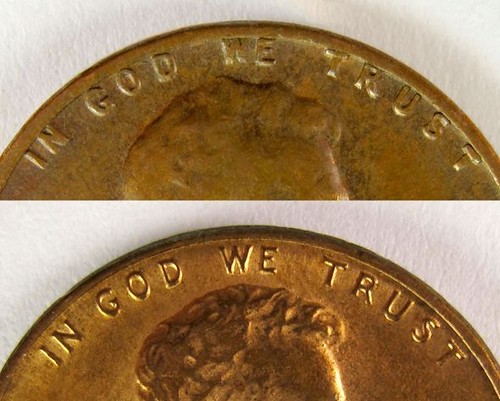
Coins are normally a job for sculptors, and President Theodore Roosevelt chose Victor David Brenner to design a new penny to celebrate the centennial of Lincoln’s birth in 1909. The new coin broke from the tradition of allegorical figures and depicted a specific person for the first time. Such practice had been explicitly avoided since independence, because many felt it tasted too much like the monarchy they had left behind. It seemed that Lincoln’s 100th birthday was the right time to drop the prohibition, and now we find it hard to imagine American currency without presidents.
The design process was marred by tension between Brenner and U.S. Mint Engraver Charles Barber, who had designed earlier coins and likely felt he should have received this commission himself. While proofing the design, Barber and Mint Director Frank Leach shifted Lincoln’s portrait towards the center of the coin, where the detail could be best rendered in striking. Troubled by the blank space above Lincoln’s head, they decided to add “IN GOD WE TRUST” along the top edge. This motto had appeared on U.S. coins for years, so Brenner could not have been surprised at its inclusion, but I can’t imagine he was happy about the tampering.
The lettering records the dissonance between the artist and his client. The “1909” figures are calmly rendered, and suggest a tool driven through clay or plaster. With awkward shapes and erratic spacing, the motto looks more like a part number brusquely stamped in. The motto would not get fixed for 60 years, after 55 billion coins had been produced.
The reverse of Brenner’s design is a beautifully balanced mass of lettering framed by sheaves of wheat, epic and quaint in the same breath. It is the pocket-sized monument that coins are meant to be, speaking for the ages from the vantage of 1909. The craft afforded here also belies the fact that this is the country’s smallest denomination. Brenner’s wheat sheaf design would also be the last time that lettering featured so prominently in U.S. coinage. It remained for 50 years, until Frank Gasparro’s rendition of the Lincoln memorial replaced it in 1959, to mark the sesquicentennial of Lincoln’s birth.
It’s not clear who updated the dies from one year to the next, though it seems obvious enough that different hands and tastes were involved. And yes, I was nuts to collect enough pennies so I could track this. Some years feature clenched shapes and tight spacing, others return to Brenner’s airy dignity. In 1934, the figure 3 is rendered with a descending end stroke. This “oldstyle” form vanishes for the rest of the ’30s, and then reappears in 1943.
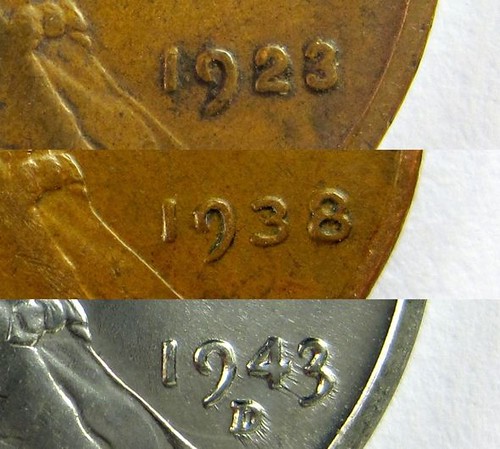
To read the complete article, see:
A Typographer’s Design History of the Unappreciated Penny
(www.slate.com/blogs/the_eye/2014/04/23/
typographer_tobias_frere_jones_design_history
_of_the_lowly_penny.html)
To read the Frere-Jones' original blog post, see: Pennyspotting (www.frerejones.com/blog/pennyspotting/)
HONEY, I SHRUNK THE MEDALS!
I learned of a product this week that is used by my sculptor friends which could have a delirious effect in numismatics. It is a polymer that can enlarge or reduce a relief item, as a coin or medal. A sculptor wrote about this product in the latest issue of AMSA Members Exchange. She used it in her modelling of small reliefs and sculpture-in-the round.
She also stated it could be used for resizing medals. That was the red flag in my face. Widespread use of this polymer could alter genuine numismatic items by changing their size. I foresee some eBay seller offering one of these as a "one-of-a-kind pattern."
The polymer -- I refuse to name the product to discourage copyists -- is fairly easy to use. It is mixed with very cold water and the genuine item is pressed into the rubbery substance to form a mold. It requires time to cure, enlarging as it dries.
A similar polymer product reduces the size. "I have reduced a 15-inch model down to a 3-inch medal in four steps, repeating this process," she boasts.
A positive cast must be made from this mold -- or two different molds for a two-sided medal. Perhaps the end product would not fool an experienced numismatist, provided the original was a struck medal.
What if the genuine were a cast medal, as so many productions are of such form -- medallic objects made by modern medallists the world over, Or worse yet, Renaissance medals of tremendous rarity and value, most all of which are cast. For readers who would like to learn the diagnostics between striking and casting, read my article at my MEDALBLOG: How to Tell Struck Medals from Cast (medalblog.wordpress.com/2012/03/26/how-to-tell-struck-medals-from-cast/).
Numismatists easily recognize oversize flans of past attempts to make oversize copies. This was accomplished by placing the coin between two hard-rubber slabs. This ensemble is then placed in a vise and squeezed. It might take several attempts to make a significant enlarged item.
Experienced numismatists know there is no such thing as a '"rubber die'" that can strike oversize or undersize items. For small size coins these are often removed from aluminum encased frames.
Thus there are no oversize or undersize item made at the mint. These are most often homemade fabrications.
THE EMPIRE COIN COMPANY OFFICE
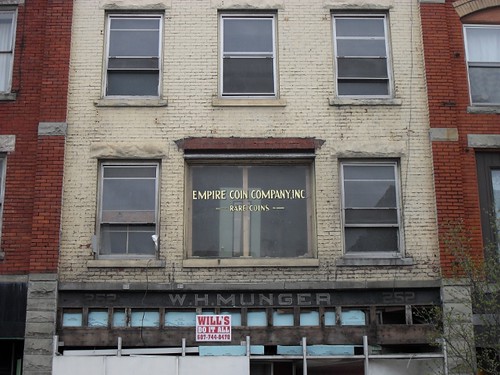
The building is at 252 Main St. Johnson City, NY.
"Broadstruck" wrote:
Here's one of Dave Bowers 1961-62 circa HK-854A White Metal Continental Dollar SC$1 re-strikes counter stamped with his Empire Coin Company store card during his early days with partner Jim Ruddy. The store card obverse motif is copied from the 1787 IMMUNIS COLUMBIA copper and the reverse from a $5 gold coin of 1795 these being the Empire Coin Company trademark. The obverse states Empire Coin Company Inc. and the reverse Professional Numismatists.

To read the complete discussion thread, see: Semi-historical piece of numismatic real estate. Empire Coin Co., Inc. (forums.collectors.com/messageview.cfm?catid=26&threadid=916587)
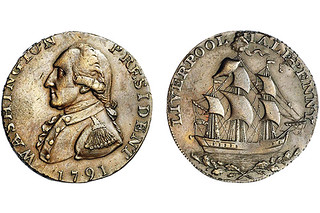 In the early 1960s, I made frequent trips to London where I made the rounds of the dealers — Spink & Son, B.A. Seaby Ltd., Baldwin’s, and the newly established Stewart Ward — to buy British, American and other interesting coins for inventory back in New York at Empire Coin Co. Jim Ruddy often traveled with me.
In the early 1960s, I made frequent trips to London where I made the rounds of the dealers — Spink & Son, B.A. Seaby Ltd., Baldwin’s, and the newly established Stewart Ward — to buy British, American and other interesting coins for inventory back in New York at Empire Coin Co. Jim Ruddy often traveled with me.
British sellers, generally conservative by nature, probably viewed me has having more money than good sense. In any event, word quickly spread around England that I would make instant decisions, make good offers, and would pay immediately.
Seaby was located in offices one flight up the stairs from the street. Laurence Brown usually greeted me, founder (in 1927) Bert Seaby was sometimes on hand, and staffers were always warm and friendly. I usually headed for Monica Bussell, nicknamed the “Copper Lady,” who had charge of coins, tokens and medals struck in that metal. She always offered a nice selection of Talbot, Allum & Lee, Washington Ship halfpennies, Rosa Americana pieces, and other copper tokens issued in England but with American-related motifs. These were and still are listed in A Guide Book of United States Coins.
Each time I visited London, the Copper Lady would have fresh stock. I had two advantages: (1) Coins in high grades were usually called “Good EF.” Some coins were, indeed, no better than an American EF. However, some measured fully up to American standards for Uncirculated. (2) I bought at dealer’s wholesale, adding an advantage. The result was that if I spent £1,000 sterling (about $3,250) I returned home with inventory worth the best part of $10,000.
To read the complete article, see: Trips to London in the 1960s yielded many examples of early token coinage for one American coin dealer (www.coinworld.com/insights/American-in-1960s-London-finds-plenty-of-coins.html)
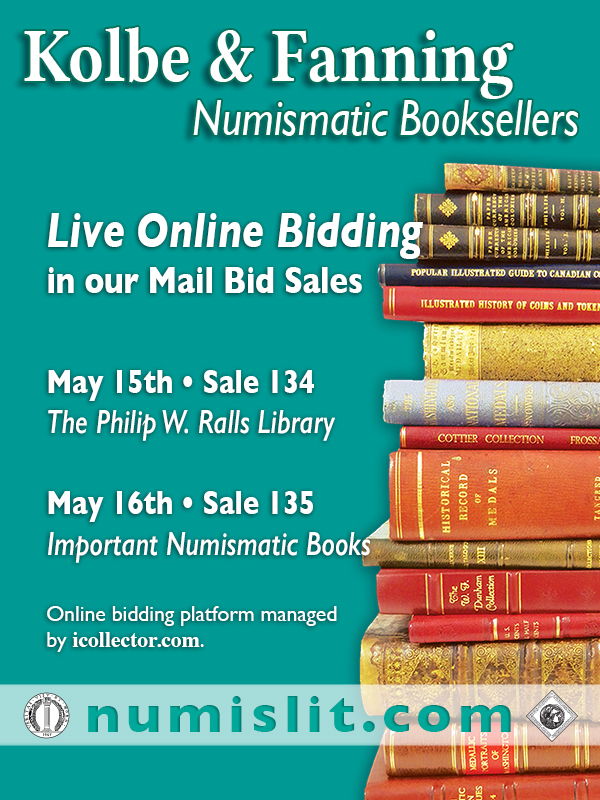
1978 NEW YORK ASSAY OFFICE GOLD THEFT
MINT THEFT -- US ASSAY OFFICE, NYC
Fall of 1978
By: Robert J. Leuver
Office of the Secretary, US Department of Treasury
An employee of the NYC US Assay Office was apprehended stealing a gold cathode weighing about 16 pounds in the Fall of 1978. The culprit allegedly had been doing this for some time. US Mint Director Stella Hackel had been visiting the Assay Office and was anxious to depart at 4:30 pm to catch a flight to D.C. The Assay Office Captain of uniformed security went out from the office where Miss Hackel was to assist and sped the processing of the onrush of employees leaving the facility. That crowded the 8 by 3 check-out table.
The culprit had cleared the end of the eight-hour shift in the electroplating "plant" wherein employees where closeted in the room for the entire work period. Standing 6'4" and the cathode held high in his morning copy of the New York Times, he towered above the guard with the magnetic wand. However at check out, he laid the paper with the cathode at the end of the table and his wallet and keys in front of the Captain. The Captain quickly processed the wallet and shoved it to the end of the table hitting the NY Times paper. The cathode clattered to the floor.
The employee was held and arrested by the Secret Service. He was arraigned the next morning and pleaded innocent. A known Mafia attorney appeared during arraignment. As the Secret Service agents waited to question the culprit, a bailiff informed the them that the attorney had used cash for the high bail.
Secret Service agents rushed to the employee's known Soho apartment. They found an apartment outfitted well beyond the means of the employee's salary. When apprehended a day later, the employee confessed to the theft and stated he had stolen a previous cathode and sold it to an unknown gentlemen, who had been recommended, who sat at the second bench from the entrance of Central Park at 59th and Fifth Avenue, across from the Plaza Hotel.
After the employee was sentenced for a relatively short term, the episode hit the front page of the NY Times, headlined, "Million Dollar Gold Theft at US Assay Office". W. Michael Blumenthal, Treasury Secretary, directed me, Bob Leuver, to head a team of Secret Service agents and Mint and Office of the Secretary personnel to determine how the theft occurred, how much was actually stolen, and what means needed to be implemented to prevent further thefts.
We determined that: 1) most probably only $250,000 in cathodes was stolen; 2) there were two sets of accounting records for smelting gold-ladened ore; 3) gold dust was being regularly "walked out" in the cuffs of pants of employees as the bottom of the magnetic frame at security checkout was five inches above the floor.
The Secretary publicly announced that only $250,000 in cathodes were stolen and this was so recounted in a buried item in the New York Times. However, the Secretary was concerned about the undetermined amount quite possible stolen as gold dust over many, many years--perhaps as much as 2 million dollars in value.
A weekend in Jan or early Feb 1979, Washington DC was hit by a massive snow storm. We were wrapping up our study. A Secret Service agent and I decided to take a train on Monday afternoon. I wanted to tie up loose ends. I spent the weekend working on a draft of the study. I intended to drop off the study to my secretary Monday morning. The Federal Government was shut down. I bundled my study in my attaché case and worked on the draft on the train.
We checked into a less than satisfactory hotel--but close to our per diem limit of $51 for hotel and meals--just off Times Square in. The Secret Service agent and I went out for a quick bite of food.
Returning, I found my attaché case missing. My Cross pen and pencil I had lain on top of the case were atop the bed spread. I went down to the desk. The head of security tried to put me off until I said, "Call Secret Service Agent ... in room ..." Attitude change! Six uniformed NYC police came and a platoon of NY Secret Service agents. The police were efficient. As the last one left he said, "Mr. Leuver, welcome to New York."
The Secret Service agents, except for my companion waited in the hall. After the uniforms left they entered and offered counsel. They said that I was probably trailed from our apartment in Arlington, VA, and on the train. It was lucky that I was accompanied by a SS agent. They reasoned that their prior study indicated that the Mafia orchestrated the Assay thefts or were participants. The Mafia probably thought my study would implicate them--it didn't. The SS troop told me to call my wife, Hilda, and tell her to change the locks on the apartment and the car--a Cadillac but only two months old. My keys were in the attaché case. The apartment people changed the locks within one half hour. Unfortunately, I had to pay to change the locks on the Cadillac, which was done Wednesday morning. People in the DC area are very understanding of government issues.
The attaché case was found in Brooklyn on Wednesday morning bereft of contents. My ID tag was on the case and the grandmother of the boy who found it called our apartment. The SS agents investigated, but there was no evidence....
To read the earlier E-Sylum article, see: THE TOP FIVE MOST NOTORIOUS MINT ROBBERIES (www.coinbooks.org/esylum_v17n13a25.html)
INSIDE STORY OF THE SACAGAWEA DOLLAR
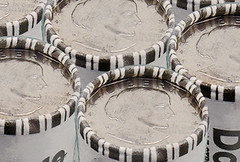 The complete story of how the Sacagawea dollar (aka, the Golden dollar) came to be has never been told, and the accounts that have been published get many of the details wrong.
The complete story of how the Sacagawea dollar (aka, the Golden dollar) came to be has never been told, and the accounts that have been published get many of the details wrong.
The story of the Sacagawea dollar cannot be understood outside the context of the failure of the Susan B. Anthony dollar (SBA) in 1980. When dollar coin legislation was filed in 1995, I conducted a quick post-mortem of the SBA to understand the causes of its failure.
The first thing I discovered was the remarkable fact that the experience was so negative for Mint staff you’d have thought it happened a year ago. The Mint was so thoroughly criticized, scapegoated really, that no one wanted to contemplate going through it all again.
I also discovered that the Mint had little to do with the SBA’s failure. Treasury had conducted a good analysis of what was required to make a new dollar coin successful, which Congress and Treasury largely ignored. In particular, the SBA was not sufficiently distinctive to avoid confusion with the quarter and, most crucially, the dollar note was not withdrawn along with introduction of the SBA. The Mint simply followed orders from Congress and Treasury.
It didn’t help that the coin lacked aesthetic appeal. I was told that Treasury secretary Michael Blumenthal found the design so unattractive that he initially rejected it, but that Ms. Anthony’s descendants insisted the coin reflect a realistic depiction of her.
The Mint was a very dysfunctional organization in 1995, and virtually everything that needed to be done to overhaul the place required an Act of Congress—literally. Addressing serious management issues stemming from political patronage, fixing the Mint’s financial management and information systems, acquiring modern coin production technology, improving customer service, increasing die-making capacity, reducing workplace injuries, transforming our security guards into a modern police force–all of it required enactment of legislation.
There was no way to do any of this while keeping a low profile. I had spent much of my career in and around politics and government, including in the U.S. Senate, and I had a pretty good understanding how to get things done. I was sworn in a director of the Mint in June 1994, and six months later Republicans took control of Congress-bad news for a Democratic administration. However, it worked out well for my agenda.
I developed strong partnerships with the Republican chairmen of two key House committees, Jim Lightfoot (Iowa) and Mike Castle (Delaware), and with Democrats Steny Hoyer (Maryand) and Senator Paul Sarbanes (Maryland). This was another time, when it was still possible for Democrats and Republicans to work together for a common goal. It wouldn’t be possible today. But the overhaul of the Mint is another story.
To read the complete article, see: The Real Diehl: The Inside Story of the Sacagawea Dollar (www.coinweek.com/featured-news/real-diehl-inside-story-sacagawea-dollar/)
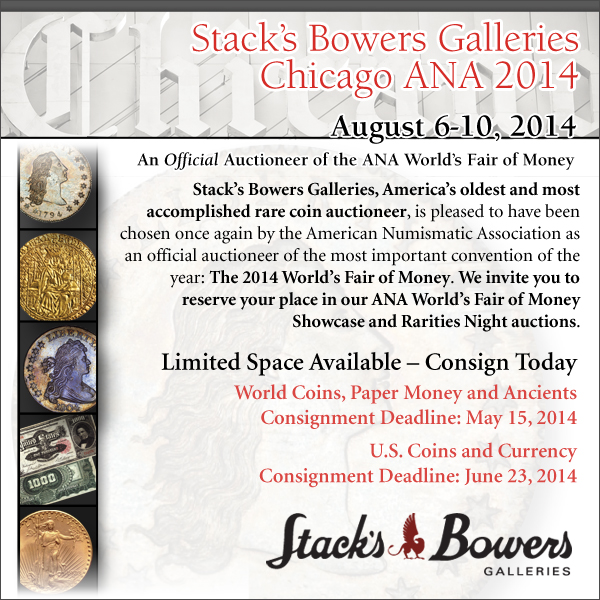
MORE ON THE FINLAND 10 EURO LITERACY COIN


Bob Neale writes:
The symbols on the other side of the Finland 10 Euros coin resemble chromosomes. The chromosomes, if such they are, would be human, of which there are 23 pairs normally. But a closer look at a reference chart suggests that the coin is not showing a map of human chromosomes. Hope someone can say for sure - whatever the answer. Got a biologist on your list to confirm - or trash as nonsense?
Chip Howell found the following explanation for us on the Finnish Mint web site:
The note ring is followed by a ring made up of Braille dots, while the outermost ring consists of letters which spell out LUKUTAITO 2014 ('LITERACY 2014'). The Swedish word for literacy, LÄSFÄRDIGHET, features on the rim of the coin. The reverse of the coin features cave painting patterns forming a ring. The text SUOMI FINLAND and the denomination – €20 or €10 – are on the outer edge.
So - it's cave painting art. Interesting! Never saw that on a coin, although I'm sure there must be medals somewhere of the subject or caves and cave paintings. Does anyone know of any? Pabitra Saha also forwarded this explanation and link. Thanks, everyone.
To read the complete description, see: Literacy €20 in cardboard package (www.suomenrahapaja.fi/eng/lukutaito-20-pahvipakkauksessa/17634/dp?openGroup=384)
To read the earlier E-Sylum article, see: SOME RECENT COIN DESIGNS: APRIL 20, 2014 : Finland 10 Euro Literacy Coin (www.coinbooks.org/esylum_v17n17a16.html)
CANADIAN COIN DESIGNER KENDRA DIXSON INTERVIEWED
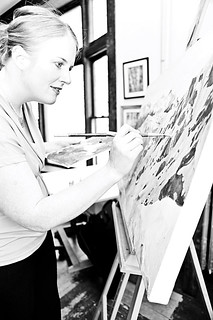 At first she thought the voice message she received was a practical joke being played on her by a friend, but listening closer she realized the invitation was real.
At first she thought the voice message she received was a practical joke being played on her by a friend, but listening closer she realized the invitation was real.
The invitation had come from the Royal Canadian Mint asking Kendra (Smith) Dixson to submit designs for the minting of collectible silver coins.
Just to be on the safe side, Kendra sent five different designs for the mint to choose from and was thrilled when two of her designs featuring alpine skiers in wooded winter settings had been chosen.
Ironically she says neither of the selections were the one she expected to win.
Two of her scenes were engraved for the 2014 Fine Silver Coins O Canada collection. One design appears on the one-ounce $25 silver coin and the other appears on the half-ounce $10 silver coin.
Growing up in the Williams Lake area, Kendra says that in high school she might have been voted the least likely to become a snowboard bum, but that choice in life is exactly what led her to become an artist and ultimately being invited by the Royal Canadian Mint to submit designs for the coins.
To read the complete article, see: French, to snowboard bum, to artist: Kendra Smith designs collector coins (www.wltribune.com/community/256260331.html)
COMMEMORATIVE COIN ON RUSSIA'S CRIMEA SIEZURE
For anyone who blinked and missed Russian President Vladimir Putin's swift seizure and annexation of Ukraine's Crimea region, there's now a giant silver coin celebrating the Kremlin leader for bringing the territory "back home."
The coins issued by the Art Grani foundry in the Russian city of Chelyabinsk feature Putin's bas relief image on one side and a map of the Crimean peninsula on the other.
"Crimea's reunification with Russia was a historic event which we decided to embody in a souvenir collection of coins,” Vladimir Vasyukhin, director of the Ural Mountains foundry, told the Itar-Tass news agency.
Vasyukhin last year visited Crimea and returned with fond memories of the peninsula, Komsomolskaya Pravda reported in its article Tuesday about the new coins.
"And just like that the peninsula has come back home to Russia," Vasyukhin said of the annexation last month. He added that with the recovery of the territory, Putin had "demonstrated the qualities of a wise strategist and politician."
The unilateral annexation has been condemned by most world powers as a violation of international law in changing another country's borders by armed force.
The first issue of 25 of the commemorative coins, which are the size of a hockey puck and weigh 2.2 pounds each, will be given to Kremlin officials, Itar-Tass said.
Neither the foundry nor the Russian news sources that wrote about the special "Crimea 2014 Collection" said how much the coins will cost or when a broader quantity will be available to collectors and the general public.
To read the complete article, see: Russian foundry issues coin celebrating Putin's Crimea seizure (www.latimes.com/world/worldnow/la-fg-wn-russia-crimea-putin-coin-20140422,0,2055770.story#axzz306IKeoyx)

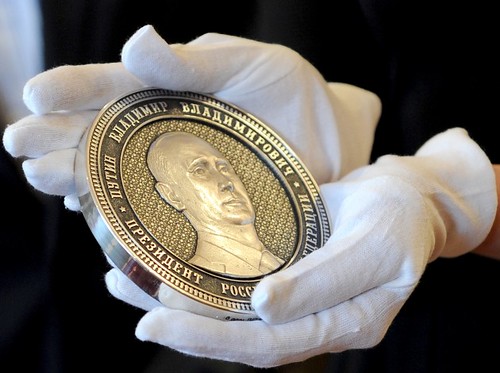
To read the complete articles, see:
Putin's Crimea seizure: the coin
(www.theage.com.au/world/putins-crimea-seizure-the-coin-20140423-zqy08.html)
Putin’s face appears on coin marking Crimea’s annexation
(www.thejournal.ie/putin-coin-russia-crimea-1428918-Apr2014/)
THE BOOK BAZARRE
AUSTRALIAN VICTORIA CROSS COMMEMORATIVE COINS
The Royal Australian Mint has launched coins which honor the Australian recipients of the Victoria Cross. A frosted uncirculated silver coin carries a mintage of 30,000 pieces, while a larger sized copper coin with a mintage of 5,000 is offered via ballot.
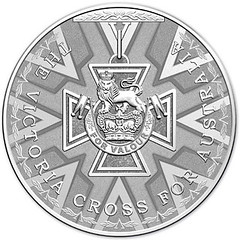

The Victoria Cross (VC) is the highest military decoration awarded for valor “in the face of the enemy” to members of the armed forces of the Commonwealth countries and previous British Empire territories. It was introduced on January 29, 1856 by Queen Victoria to honor acts of valor during the Crimean War. The VC takes precedence over all other orders, decorations, and medals and may be awarded to a person of any rank in any service as well as to civilians under military command. There have been 100 Australians who were awarded the Victoria Cross throughout its history.
The $5 silver coin features a depiction of the Victoria Cross, which consists of a bronze cross pattée with Crown and Lion superimposed and the motto “For Valour”. A surrounding inscription contains the words “The Victoria Cross For Australia”. The obverse of the coin contains the Ian Rank Broadley effigy of Queen Elizabeth II with the denomination of “5 Dollars” and the “2014″ date.
The Royal Australian Mint is also offering a $10 copper coin with an antique finish to replicate the appearance of the actual medal. The reverse design features a depiction of the Victoria Cross, which is surrounded by the names of the 100 Australian recipients. The Mint used micro text, an innovative technical minting process, to include the names of the recipients.

These coins are struck in copper with a wide diameter of 57 mm. The mintage is only 5,000 pieces.
To read the complete article, see: 2014 Victoria Cross for Australia Coins (world.mintnewsblog.com/2014/04/2014-victoria-cross-for-australia-coins/)
PERTH MINT COIN DESIGNER ING ING JONG
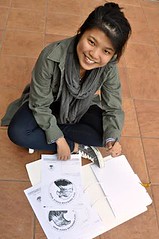 Ing Ing Jong, a Perth Mint coin designer, recently discussed with me her experience as a coin designer and her work on the new American Bald Eagle high relief silver proof coin, a stunning piece that depicts the bird’s profile in exquisite detail. The coin has a limited mintage of 5,000 units, most of which sold out quickly at various U.S. coin distributors over the past few weeks. The coin was minted by Perth on behalf of the government of Tuvalu.
Ing Ing Jong, a Perth Mint coin designer, recently discussed with me her experience as a coin designer and her work on the new American Bald Eagle high relief silver proof coin, a stunning piece that depicts the bird’s profile in exquisite detail. The coin has a limited mintage of 5,000 units, most of which sold out quickly at various U.S. coin distributors over the past few weeks. The coin was minted by Perth on behalf of the government of Tuvalu.
LG - What are the main influences on your work?
IIJ- - As a huge Disney fan, my love of illustration and animation grew naturally from a young age. I have a real passion for drawing and creating characters. I completely admire how Disney animators are able to convey the essence of the character’s emotions through their sketches. The fact that I too can put life into my designs through Perth Mint coins is very rewarding.
LG - What inspired you to create the Tuvalu high relief bald eagle coin, and to zero in on the bird’s profile, which I have never seen before in an eagle coin?
IIJ- - Following the brief, I wanted to ensure that I accurately presented the protective gaze on the birds face. As the symbol of the United States and a source of pride for the nation, the American Bald Eagle stands for strength, courage and freedom, which I aimed to reflect in my design.
LG - What are the advantages of doing the design in high relief?
IIJ- - I thoroughly enjoy working on high relief projects as the deep metal blank captures the finer features of an intricate coin design. The advantage of using high relief on the American Bald Eagle coin meant that we have a more sculpted detail emphasis on the bird’s face and neck, highlighting its amazing plumage.
LG - Please tell us a little about the process you go through when creating a coin and the technologies you use.
IIJ- - We’re very lucky that The Perth Mint provides us with a range of modern technology, making our job so much easier. We use advanced graphics tablets which enable us to hand-draw images similar to the way a person draws with a pencil and paper. When designing the American Bald Eagle coin, I started off with a sketch and then scanned it into my computer and used my tablet to render the design. Our team of talented engravers then manipulated the artwork into 3D bringing the final piece to life.
To read the earlier E-Sylum article, see: PERTH MINT COIN DESIGNER ING ING JONG (www.coinbooks.org/esylum_v16n03a30.html)
To read the complete article, see: The Coin Analyst: Interview with Ing Ing Jong, Perth Mint Coin Designer (www.coinweek.com/featured-news/coin-analyst-interview-ing-ing-jong-perth-mint-coin-designer/)
SOME INTERESTING MEDALS: APRIL 27, 2014
SOM#116: Sunrise and Moonrise

SOCIETY OF MEDALISTS ISSUE #116, 1987. 73.2mm. Bronze. Robert Cronbach, Sc. Unc. Original box and descriptive pamphlet. Obv: Reclining nude at sunrise. Rx: Reclining nude at moonrise.
The artist writes, "The use of the seal, the medal, the coins and the sculptured inscribed plaque is almost as old as recorded human history. The great range of styles, techniques and symbols in this field has always interested me.
My medal is called "Sunrise and Moonrise", or waking and sleeping. Both sides use a recumbent woman; but rely on the internal action and the auxiliary symbols to convey the contrasting moods of the two faces of the medal. The source of this sculpture is my love for, and frequent use of, the female human image as a symbol, a means and an aesthetic tool. I am much more interested in intensity of vision and freshness of form, rather than in novelty for its own sake. $49.50
1963 Project Mercury Medal

RARE PROJECT MERCURY MEDAL, 1963. 76.3mm. Bronze. Ralph J. Menconi, Sc. (MACO) Nice Uncirculated.
On the obverse are heads of the 7 Mercury astronauts (Carpenter, Cooper & Glenn/ Grissom, Shirra, Sheppard & Slayton.) Below: PROJECT MERCURY.
On the reverse, at left, is the Project Mercury symbol based on the 13 foot stainless steel monument. It is formed from the symbol for Mercury. The numeral 7 in the center represents the original 7 astronauts.
At center is the Atlas space launch vehicle and at right, the inscription: COMMEMORATING. FREE MAN’S/ FIRST ADVENTURE/ BEYOND THE/ ATMOSPHERE. 1958 . 1963.
The 13 foot monument, medals and commemoration event were sponsored by the General Dynamics Corporation. A ceremony was held to honor high NASA officials and the U.S. Air Force where a very limited number of these medals in gold (44mm), silver (44mm) bronze 76mm & 44mm) & Chromium plated Bronze (76mm) were presented.

COUNTERFEITERS OF BRITISH ONE POUND COINS ARRESTED

Two men were arrested yesterday as part of an international investigation into the counterfeiting conspiracy that forced the withdrawal of the £1 coin.
Dutch authorities said that one man, aged 63, was detained in Holland and another, aged 58, in Belgium on suspicion of transporting millions of fake £1 coins.
The arrests are linked to that of Patrick Onel, who is suspected of making 30 million high-quality forged coins since 2006 — two-thirds of the total number of fakes in circulation.
To read the complete article (subscription required), see: Two men held over counterfeit coins (www.coinbooks.org/club_nbs_esylum_v17n17.html)
To read the earlier E-Sylum article, see: ROYAL MINT TO INTRODUCE NEW ONE POUND COIN (www.coinbooks.org/esylum_v17n12a20.html)
ROYAL MINT TO OPEN VISITOR CENTRE IN 2015
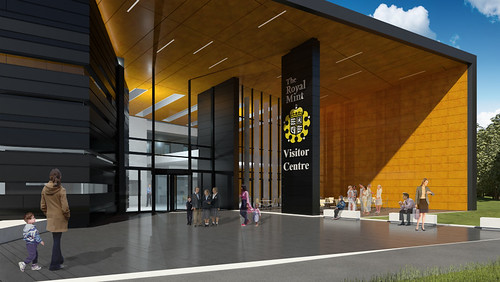
We are pleased to announce that plans are in place to develop a visitor experience here at The Royal Mint. Thanks to contributory funding from the Welsh Government a new Visitor Centre will be built at our site in South Wales. On its completion in 2015, new shiny doors will officially open The Royal Mint to the general public for the first time in our 1,000 year history! -
The visitor experience will provide a much-anticipated look behind the high-security doors of The Royal Mint – Britain’s oldest manufacturer and the world’s largest export mint! Visitors will have the opportunity to take a tour of The Royal Mint to see just how the coins they use every day are made. On top of that a range of static and interactive exhibitions in the new Visitor Centre will add to an experience topped off by the chance to strike your very own coin!
With over 1,000 years of manufacturing and a museum on-site with more than 80,000 artefacts the new visitor experience provides an opportunity to explore the in-depth history behind the coins and medals we make.
Opened by The Queen herself on 17th December 1968, we moved to the purpose-built site in Llantrisant following 157 years at Tower Hill, London. The need to move to a larger site was recognised in the 1950’s but it was the task of decimalising UK currency that prompted the eventual move.
Development of the visitor experience is scheduled to begin this Spring and is expected to be completed in 2015. If you are interested in following the developments of the visitor experience you can register your interest at royalmint.com to receive future updates by email.
To read the complete article, see: Opening the doors to The Royal Mint! (blog.royalmint.com/opening-the-doors-to-the-royal-mint-visitor-centre/)
THE BOOK BAZARRE
SHOCKING DISCOVERY: DOLLAR BILLS CARRY BACTERIA
 Talk about dirty money: Scientists are discovering a surprising number of microbes living on cash.
Talk about dirty money: Scientists are discovering a surprising number of microbes living on cash.
In the first comprehensive study of the DNA on dollar bills, researchers at New York University's Dirty Money Project found that currency is a medium of exchange for hundreds of different kinds of bacteria as bank notes pass from hand to hand.
By analyzing genetic material on $1 bills, the NYU researchers identified 3,000 types of bacteria in all—many times more than in previous studies that examined samples under a microscope. Even so, they could identify only about 20 percent of the non-human DNA they found because so many microorganisms haven't yet been cataloged in genetic data banks.
Easily the most abundant species they found is one that causes acne. Others were linked to gastric ulcers, pneumonia, food poisoning and staph infections, the scientists said. Some carried genes responsible for antibiotic resistance.
"It was quite amazing to us," said Jane Carlton, director of genome sequencing at NYU's Center for Genomics and Systems Biology where the university-funded work was performed. "We actually found that microbes grow on money."
Their unpublished research offers a glimpse into the international problem of dirty money. From rupees to euros, paper money is one of the most frequently passed items in the world. Hygienists have long worried that it could become a source of contagion.
"A body-temperature wallet is a petri dish," said Philippe Etienne, managing director of Innovia Security Pty Ltd., which makes special bank-note paper for 23 countries.
To read the complete article, see: Researchers find thousands of bacteria living on cash (www.foxnews.com/health/2014/04/21/researchers-find-thousands-bacteria-living-on-dollar-bills/)
TWELVE GOLD BARS FOUND IN MAN'S STOMACH
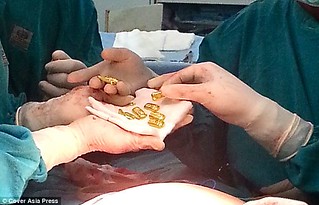 Doctors in India were shocked to find 12 gold bars inside the stomach of a businessman who was admitted after complaining of pains.
Doctors in India were shocked to find 12 gold bars inside the stomach of a businessman who was admitted after complaining of pains.
The 63-year-old man went to a hospital in Delhi earlier this month saying he had swallowed a cap from a water bottle and wanted it removed from his body.
He also complained of pain and vomiting prompting surgeons to operate, when they discovered the hoard thought to be worth around £13,900.
And now it is understood that customs officials have questioned the man and the gold has been confiscated.
Senior consulting surgeon at Sir Ganga Ram Hospital in Dehli Dr C S Ramachandran told the Indian Express: 'He approached us on April 7 seeking surgery to remove a water bottle cap which he claimed he had accidentally swallowed.
'We got an X-ray done and it didn’t appear to be a cap. As the gold bars got stacked one behind the other it appeared to be a metal. We were shocked to find not one but 12 gold biscuits in his abdomen.
To read the complete article, see: What doctors found inside an Indian businessman after he complained of having a stomach ache (12 gold bars worth £1,100 each) (www.dailymail.co.uk/news/article-2608924/Pictured-12-gold-bars-INSIDE-businessman-went-doctors-complaining-stomach-aches.html)
FEATURED WEB SITE: MINT DIRECTORS’ CONFERENCE 2014
This week's Featured Web Site is the Official Web Site of the 2014 Mint Directors’ Conference, to be held next month in Mexico City.Welcome to the Official Web Site of the XXVIII Mint Directors’ Conference! This important conference will be hosted by Casa de Moneda de México and will be held from the 11th to the 17th of May 2014. Minting industry representatives from around the world will gather in Mexico City during this time to discuss and exchange information on all monetary matters and related legal, economic, technical and numismatic issues. The Post-Conference Tour includes a three-day stay in beautiful Mayan Riviera.

mdc2014.com/eng/home.html
